2007 GMC CANYON manual transmission
[x] Cancel search: manual transmissionPage 295 of 492
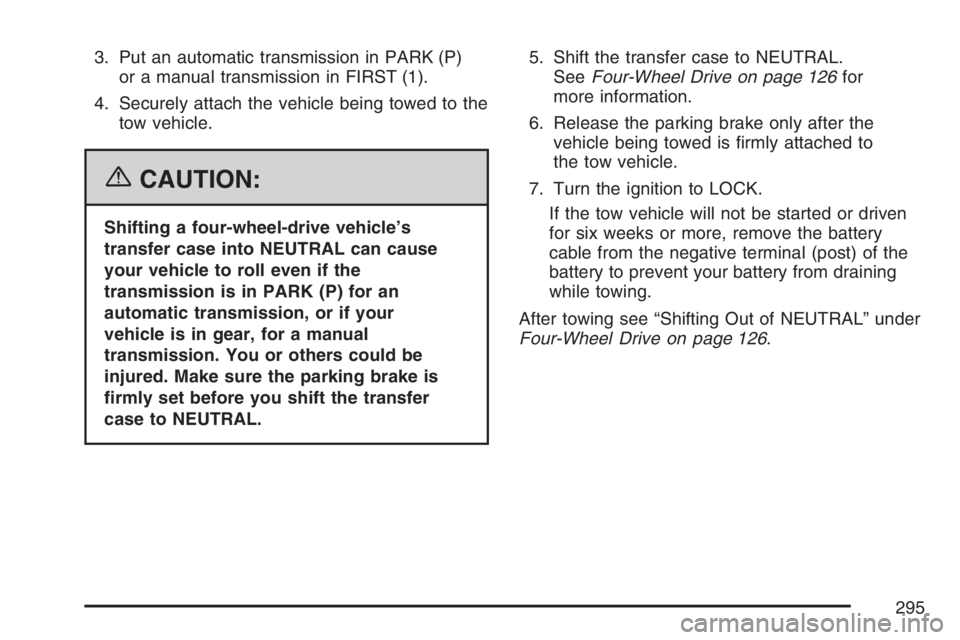
3. Put an automatic transmission in PARK (P)
or a manual transmission in FIRST (1).
4. Securely attach the vehicle being towed to the
tow vehicle.
{CAUTION:
Shifting a four-wheel-drive vehicle’s
transfer case into NEUTRAL can cause
your vehicle to roll even if the
transmission is in PARK (P) for an
automatic transmission, or if your
vehicle is in gear, for a manual
transmission. You or others could be
injured. Make sure the parking brake is
�rmly set before you shift the transfer
case to NEUTRAL.5. Shift the transfer case to NEUTRAL.
SeeFour-Wheel Drive on page 126for
more information.
6. Release the parking brake only after the
vehicle being towed is �rmly attached to
the tow vehicle.
7. Turn the ignition to LOCK.
If the tow vehicle will not be started or driven
for six weeks or more, remove the battery
cable from the negative terminal (post) of the
battery to prevent your battery from draining
while towing.
After towing see “Shifting Out of NEUTRAL” under
Four-Wheel Drive on page 126.
295
Page 297 of 492
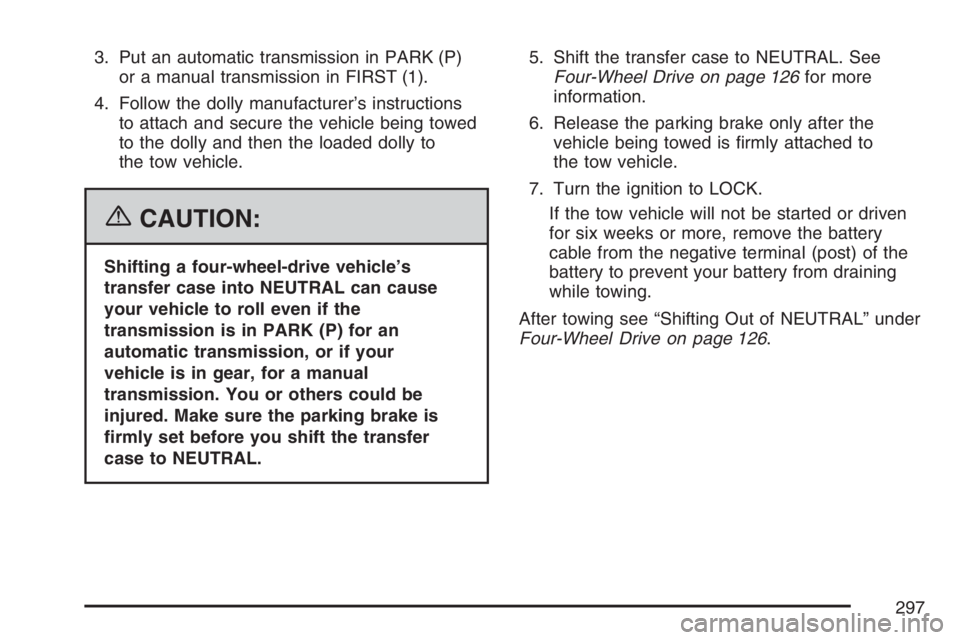
3. Put an automatic transmission in PARK (P)
or a manual transmission in FIRST (1).
4. Follow the dolly manufacturer’s instructions
to attach and secure the vehicle being towed
to the dolly and then the loaded dolly to
the tow vehicle.
{CAUTION:
Shifting a four-wheel-drive vehicle’s
transfer case into NEUTRAL can cause
your vehicle to roll even if the
transmission is in PARK (P) for an
automatic transmission, or if your
vehicle is in gear, for a manual
transmission. You or others could be
injured. Make sure the parking brake is
�rmly set before you shift the transfer
case to NEUTRAL.5. Shift the transfer case to NEUTRAL. See
Four-Wheel Drive on page 126for more
information.
6. Release the parking brake only after the
vehicle being towed is �rmly attached to
the tow vehicle.
7. Turn the ignition to LOCK.
If the tow vehicle will not be started or driven
for six weeks or more, remove the battery
cable from the negative terminal (post) of the
battery to prevent your battery from draining
while towing.
After towing see “Shifting Out of NEUTRAL” under
Four-Wheel Drive on page 126.
297
Page 298 of 492
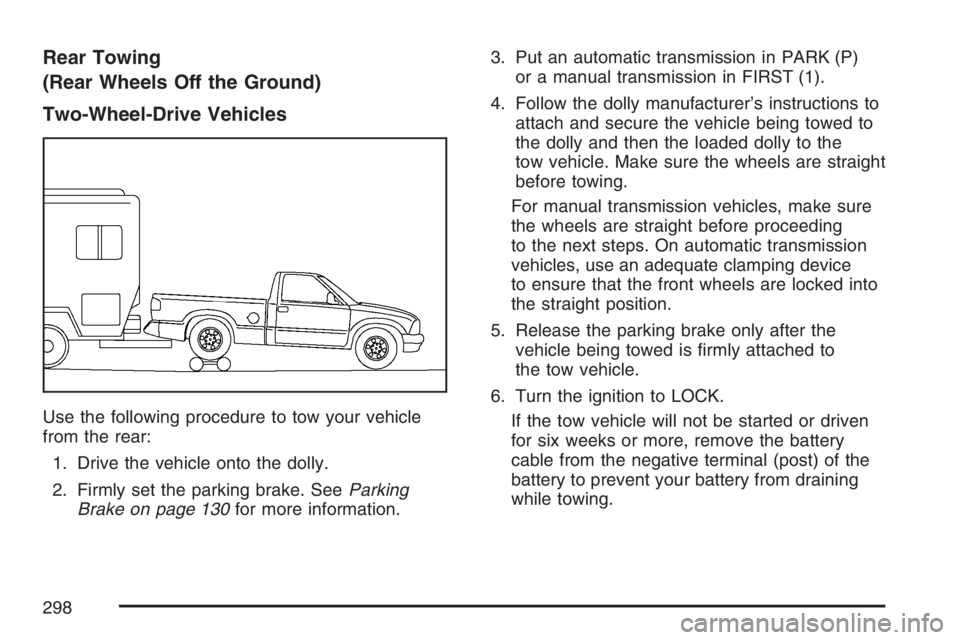
Rear Towing
(Rear Wheels Off the Ground)
Two-Wheel-Drive Vehicles
Use the following procedure to tow your vehicle
from the rear:
1. Drive the vehicle onto the dolly.
2. Firmly set the parking brake. SeeParking
Brake on page 130for more information.3. Put an automatic transmission in PARK (P)
or a manual transmission in FIRST (1).
4. Follow the dolly manufacturer’s instructions to
attach and secure the vehicle being towed to
the dolly and then the loaded dolly to the
tow vehicle. Make sure the wheels are straight
before towing.
For manual transmission vehicles, make sure
the wheels are straight before proceeding
to the next steps. On automatic transmission
vehicles, use an adequate clamping device
to ensure that the front wheels are locked into
the straight position.
5. Release the parking brake only after the
vehicle being towed is �rmly attached to
the tow vehicle.
6. Turn the ignition to LOCK.
If the tow vehicle will not be started or driven
for six weeks or more, remove the battery
cable from the negative terminal (post) of the
battery to prevent your battery from draining
while towing.
298
Page 299 of 492

Four-Wheel-Drive Vehicles
Use the following procedure to tow your vehicle
from the rear:
1. Drive the vehicle onto the dolly.
2. Firmly set the parking brake. SeeParking
Brake on page 130for more information.
3. Put an automatic transmission in PARK (P)
or a manual transmission in FIRST (1).
4. Follow the dolly manufacturer’s instructions
to attach and secure the vehicle being towed
to the dolly and then the loaded dolly to
the tow vehicle.For manual transmission vehicles, make sure
the wheels are straight before proceeding
to the next steps. On automatic transmission
vehicles, use an adequate clamping device
to ensure that the front wheels are locked into
the straight position.
{CAUTION:
Shifting a four-wheel-drive vehicle’s
transfer case into NEUTRAL can cause
your vehicle to roll even if the
transmission is in PARK (P) for an
automatic transmission, or if your vehicle
is in gear, for a manual transmission.
You or others could be injured. Make sure
the parking brake is �rmly set before you
shift the transfer case to NEUTRAL.
5. Shift the transfer case to NEUTRAL. See
Four-Wheel Drive on page 126for more
information.
6. Release the parking brake only after the
vehicle being towed is �rmly attached to the
tow vehicle.
299
Page 301 of 492
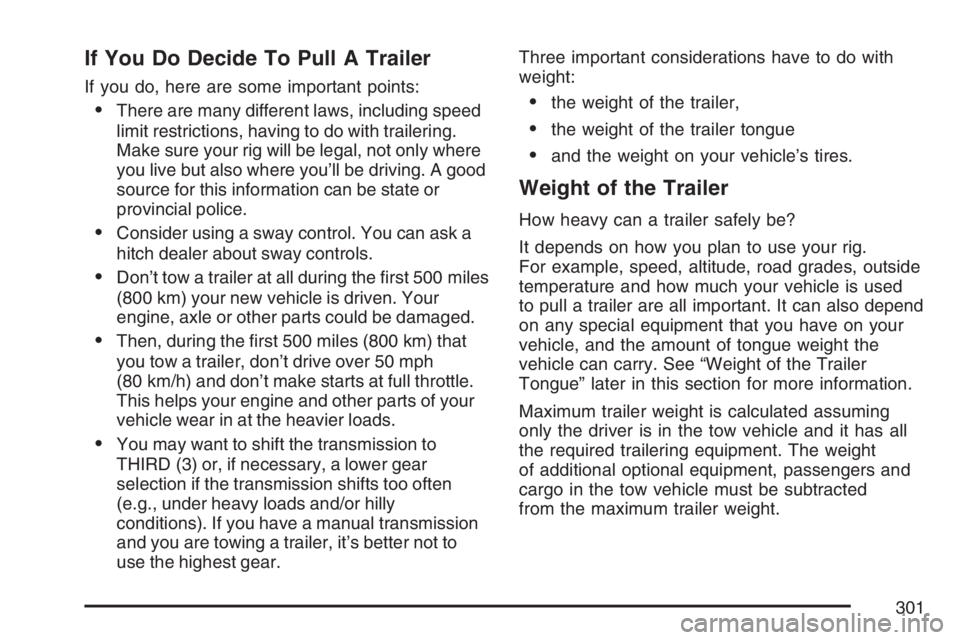
If You Do Decide To Pull A Trailer
If you do, here are some important points:
There are many different laws, including speed
limit restrictions, having to do with trailering.
Make sure your rig will be legal, not only where
you live but also where you’ll be driving. A good
source for this information can be state or
provincial police.
Consider using a sway control. You can ask a
hitch dealer about sway controls.
Don’t tow a trailer at all during the �rst 500 miles
(800 km) your new vehicle is driven. Your
engine, axle or other parts could be damaged.
Then, during the �rst 500 miles (800 km) that
you tow a trailer, don’t drive over 50 mph
(80 km/h) and don’t make starts at full throttle.
This helps your engine and other parts of your
vehicle wear in at the heavier loads.
You may want to shift the transmission to
THIRD (3) or, if necessary, a lower gear
selection if the transmission shifts too often
(e.g., under heavy loads and/or hilly
conditions). If you have a manual transmission
and you are towing a trailer, it’s better not to
use the highest gear.Three important considerations have to do with
weight:
the weight of the trailer,
the weight of the trailer tongue
and the weight on your vehicle’s tires.
Weight of the Trailer
How heavy can a trailer safely be?
It depends on how you plan to use your rig.
For example, speed, altitude, road grades, outside
temperature and how much your vehicle is used
to pull a trailer are all important. It can also depend
on any special equipment that you have on your
vehicle, and the amount of tongue weight the
vehicle can carry. See “Weight of the Trailer
Tongue” later in this section for more information.
Maximum trailer weight is calculated assuming
only the driver is in the tow vehicle and it has all
the required trailering equipment. The weight
of additional optional equipment, passengers and
cargo in the tow vehicle must be subtracted
from the maximum trailer weight.
301
Page 302 of 492
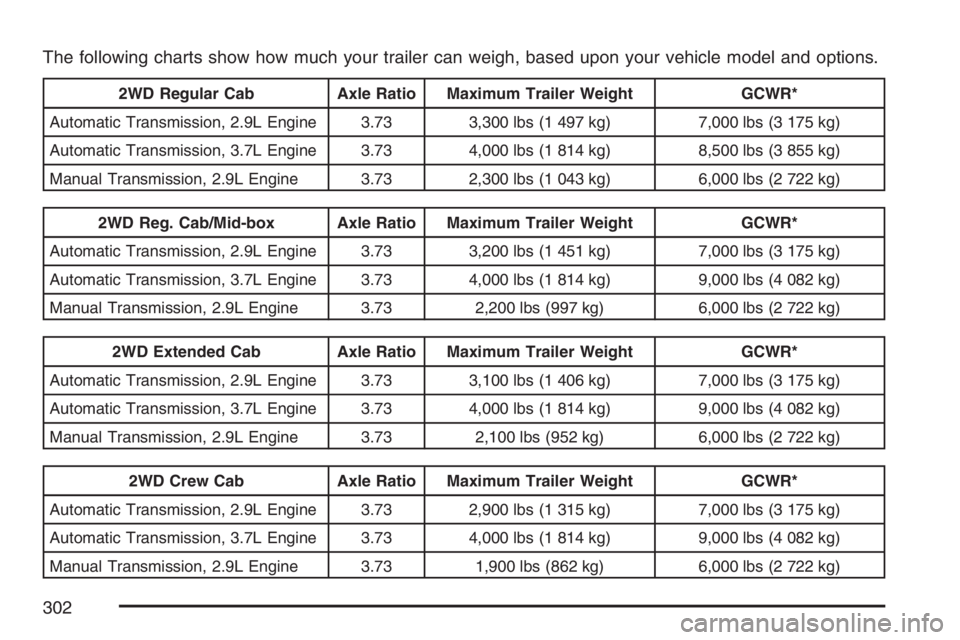
The following charts show how much your trailer can weigh, based upon your vehicle model and options.
2WD Regular Cab Axle Ratio Maximum Trailer Weight GCWR*
Automatic Transmission, 2.9L Engine 3.73 3,300 lbs (1 497 kg) 7,000 lbs (3 175 kg)
Automatic Transmission, 3.7L Engine 3.73 4,000 lbs (1 814 kg) 8,500 lbs (3 855 kg)
Manual Transmission, 2.9L Engine 3.73 2,300 lbs (1 043 kg) 6,000 lbs (2 722 kg)
2WD Reg. Cab/Mid-box Axle Ratio Maximum Trailer Weight GCWR*
Automatic Transmission, 2.9L Engine 3.73 3,200 lbs (1 451 kg) 7,000 lbs (3 175 kg)
Automatic Transmission, 3.7L Engine 3.73 4,000 lbs (1 814 kg) 9,000 lbs (4 082 kg)
Manual Transmission, 2.9L Engine 3.73 2,200 lbs (997 kg) 6,000 lbs (2 722 kg)
2WD Extended Cab Axle Ratio Maximum Trailer Weight GCWR*
Automatic Transmission, 2.9L Engine 3.73 3,100 lbs (1 406 kg) 7,000 lbs (3 175 kg)
Automatic Transmission, 3.7L Engine 3.73 4,000 lbs (1 814 kg) 9,000 lbs (4 082 kg)
Manual Transmission, 2.9L Engine 3.73 2,100 lbs (952 kg) 6,000 lbs (2 722 kg)
2WD Crew Cab Axle Ratio Maximum Trailer Weight GCWR*
Automatic Transmission, 2.9L Engine 3.73 2,900 lbs (1 315 kg) 7,000 lbs (3 175 kg)
Automatic Transmission, 3.7L Engine 3.73 4,000 lbs (1 814 kg) 9,000 lbs (4 082 kg)
Manual Transmission, 2.9L Engine 3.73 1,900 lbs (862 kg) 6,000 lbs (2 722 kg)
302
Page 303 of 492
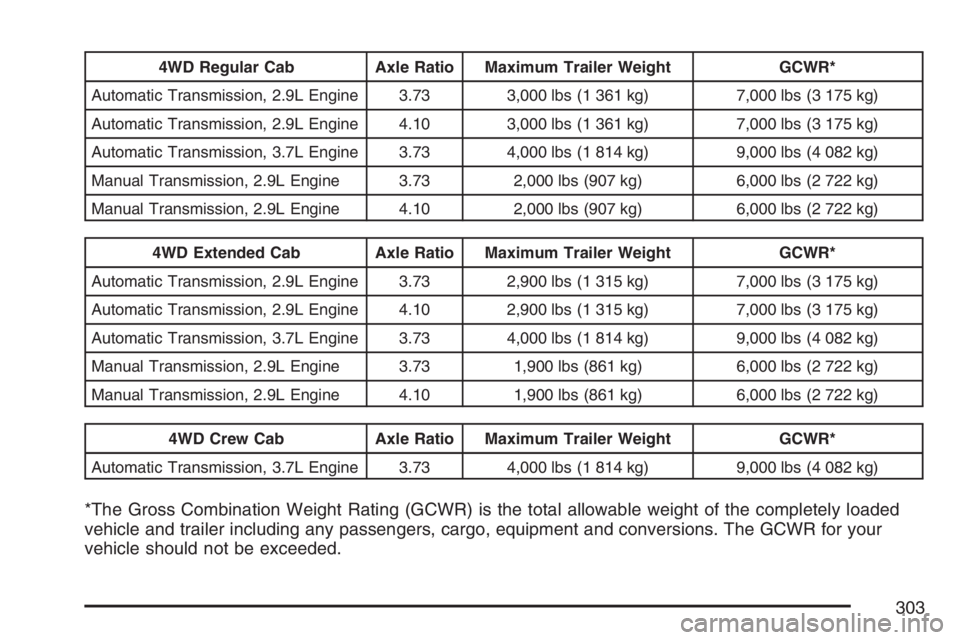
4WD Regular Cab Axle Ratio Maximum Trailer Weight GCWR*
Automatic Transmission, 2.9L Engine 3.73 3,000 lbs (1 361 kg) 7,000 lbs (3 175 kg)
Automatic Transmission, 2.9L Engine 4.10 3,000 lbs (1 361 kg) 7,000 lbs (3 175 kg)
Automatic Transmission, 3.7L Engine 3.73 4,000 lbs (1 814 kg) 9,000 lbs (4 082 kg)
Manual Transmission, 2.9L Engine 3.73 2,000 lbs (907 kg) 6,000 lbs (2 722 kg)
Manual Transmission, 2.9L Engine 4.10 2,000 lbs (907 kg) 6,000 lbs (2 722 kg)
4WD Extended Cab Axle Ratio Maximum Trailer Weight GCWR*
Automatic Transmission, 2.9L Engine 3.73 2,900 lbs (1 315 kg) 7,000 lbs (3 175 kg)
Automatic Transmission, 2.9L Engine 4.10 2,900 lbs (1 315 kg) 7,000 lbs (3 175 kg)
Automatic Transmission, 3.7L Engine 3.73 4,000 lbs (1 814 kg) 9,000 lbs (4 082 kg)
Manual Transmission, 2.9L Engine 3.73 1,900 lbs (861 kg) 6,000 lbs (2 722 kg)
Manual Transmission, 2.9L Engine 4.10 1,900 lbs (861 kg) 6,000 lbs (2 722 kg)
4WD Crew Cab Axle Ratio Maximum Trailer Weight GCWR*
Automatic Transmission, 3.7L Engine 3.73 4,000 lbs (1 814 kg) 9,000 lbs (4 082 kg)
*The Gross Combination Weight Rating (GCWR) is the total allowable weight of the completely loaded
vehicle and trailer including any passengers, cargo, equipment and conversions. The GCWR for your
vehicle should not be exceeded.
303
Page 309 of 492

Backing Up
Hold the bottom of the steering wheel with
one hand. Then, to move the trailer to the left, just
move that hand to the left. To move the trailer to the
right, move your hand to the right. Always back up
slowly and, if possible, have someone guide you.
Making Turns
Notice:Making very sharp turns while
trailering could cause the trailer to come in
contact with the vehicle. Your vehicle could
be damaged. Avoid making very sharp
turns while trailering.
When you’re turning with a trailer, make wider
turns than normal. Do this so your trailer
won’t strike soft shoulders, curbs, road signs,
trees or other objects. Avoid jerky or sudden
maneuvers. Signal well in advance.
Turn Signals When Towing a Trailer
When you tow a trailer, your vehicle has to have
extra wiring and a heavy-duty turn signal �asher.
The arrows on your instrument panel will �ash
whenever you signal a turn or lane change.
Properly hooked up, the trailer lamps will also
�ash, telling other drivers you’re about to
turn, change lanes or stop.When towing a trailer, the arrows on your
instrument panel will �ash for turns even if the bulbs
on the trailer are burned out. Thus, you may think
drivers behind you are seeing your signal when
they are not. It’s important to check occasionally to
be sure the trailer bulbs are still working.
Driving On Grades
Reduce speed and shift to a lower gear before
you start down a long or steep downgrade. If you
don’t shift down, you might have to use your
brakes so much that they would get hot and no
longer work well.
When towing at high altitude on steep uphill
grades, consider the following: Engine coolant
will boil at a lower temperature than at normal
altitudes. If you turn your engine off immediately
after towing at high altitude on steep uphill grades,
your vehicle may show signs similar to engine
overheating. To avoid this, let the engine run while
parked (preferably on level ground) with the
automatic transmission in PARK (P) (or the manual
transmission out of gear and the parking brake
applied) for a few minutes before turning the
engine off. If you do get the overheat warning,
seeEngine Overheating on page 340.
309